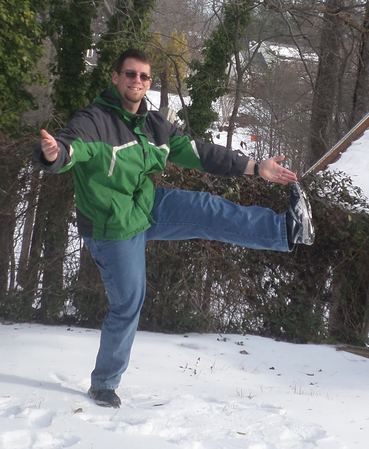 Winter time! Who doesn't love snow days? In case you don't know I live in North Carolina and we just got hit with our first big snow. Aside from the snowfall it has also been icing over night, layering the snow. Making it slick, hard to walk, and break through. The good thing about North Carolina is snow and ice doesn't last too long, but when they're here it's important to know how to walk, move, and keep your footing amid the cold. How do we do this? By following some basic Tai Chi principles, of course.
This first principle is the easiest and simplest to apply. We usually walk this way anyway. When stepping to the front or side use the heel, when stepping back use the ball//toes. When we use the heel to step forward it allows us to have better contact with the ground. If in snow we can drive the heal to dig in and make a more solid footprint. If on ice it is important to feel how slick it is, this sensitivity is only brought about by our next principle, separating the weight.
Separate your weight from one leg to the other. When you can solidly separate all your weight onto one of your legs the other is free to adapt keeping you in balance, or to feel the ground you're moving toward. Building sensitivity of your body weight is essential to keeping balance, and is closely tied into all the other principles. Weighing your limbs is also very important. In Tai Chi there's an attribute called 'song'- relaxed heaviness, that we strive to achieve in our form practice. Song is not only something we can relate to our whole body, but it is also important to know how to weigh your different joints. For example you should have a feeling of heaviness in the knees and a feeling of lightness or adaptability in the feet. When the knees are 'heavy' this allows the feet to be firmly rooted yet mobile should the need arise.Heaviness in the knees is a feeling of the leg relaxed into the ground, this 'song' feeling helps with pulling and shifting the weight. This brings us to our next principle, pull don't push. When pulling you are able to ensure how stable the ground is. If on ice you'll be able to feel any minute shift in footing by sinking and pulling with the front leg as opposed to pushing with the rear. In time you can pull and push, after footing has been established. Starting off it is important to solidify the ground by pulling with your front leg. If you've done all of the above and something still catches you off guard this last principle will help you regain balance. All movement is directed by the hips, your hips control your center of gravity, you can use this as a counterbalance and pivot. If you slip on ice sink the hips back toward the solid foot to correct your footing. Basically bring your hips back over one leg. We practice the form to learn this sensitivity. In this way we can react to a sudden shift in equilibrium. Again the important thing is learn to separate the weight. Step strong my friends, sink your weight solidly into your feet and don't allow any hardship to sway your path toward deeper understanding... Until next time, stay frosty.
2 Comments
Virginia Hawn
1/17/2018 02:24:07 pm
Love the toe stretch! Got to balance in this slippery weather!
Reply
Marilyn Clayton
1/17/2018 06:46:49 pm
I used the hip sink unconsciously when I slipped on a wet board when hiking. I instinctively lowered my weight into a low crouch with my left hip over my stable left leg. Thomas also grabbed me under the arms after I did that. The hip sink saved me from potential serious injury. Perhaps my intermittent practice of Tai chi taught my body how to react. This is my testimony to the power of Tai chi!
Reply
Leave a Reply. |
Your AuthorDaniel R. Hyde
Licensed Massage Therapist OIF, OEF Veteran U.S. Marine Corps Instructor of: Kwan Ying Do Kung Fu Tai Chi Chuan Chi Kung Tui Na, Chinese Massage Thai Massage Shiatsu, Japanese Massage Archives
May 2021
Categories |


 RSS Feed
RSS Feed
